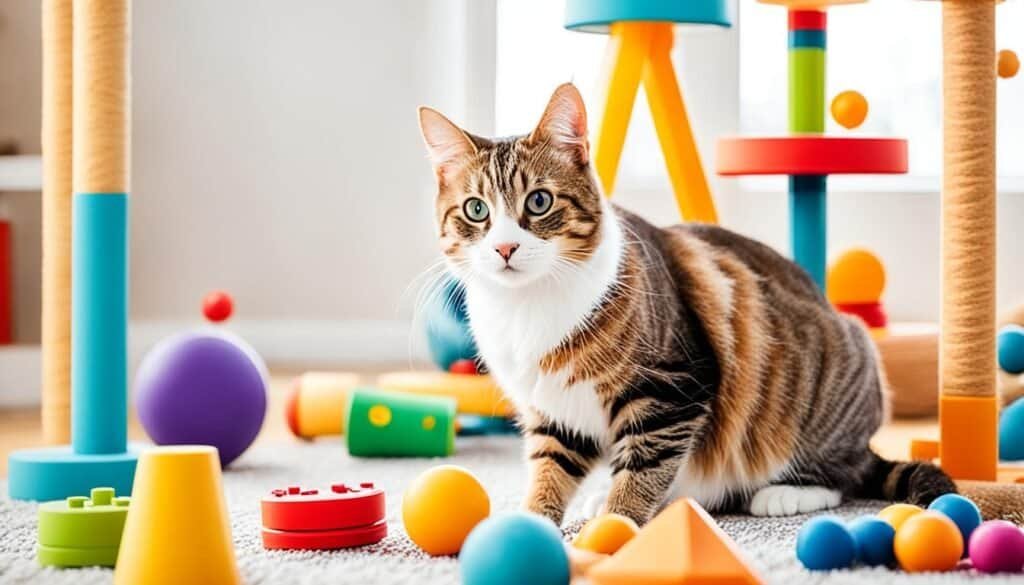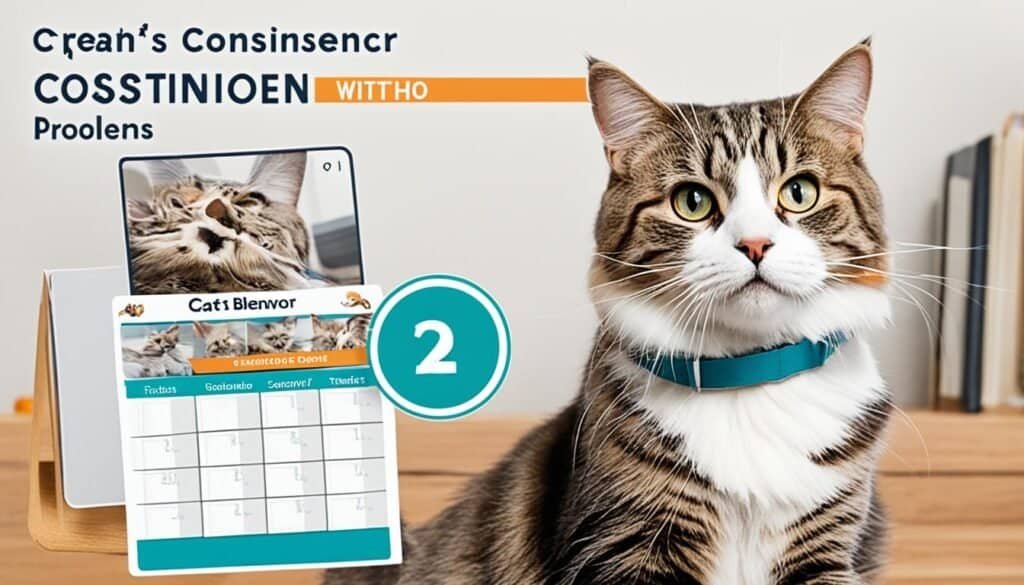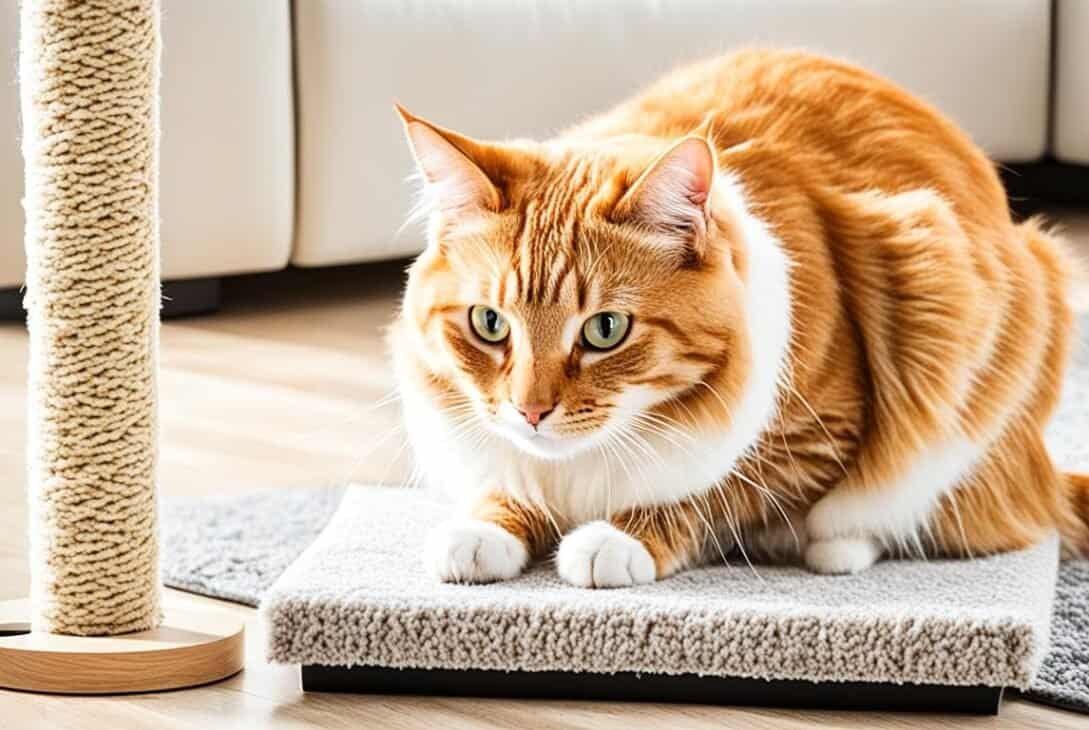Is your cat exhibiting problem behaviors that are causing frustration and tension in your home? Don’t worry, we’ve got you covered. In this article, we will explore effective solutions to address various cat behavior problems, offering proven techniques and strategies to modify and manage troublesome behaviors.
Understanding cat problem behavior solutions are crucial in effectively tackling them. By recognizing the common issues and their underlying reasons, you can approach the training process with confidence and ensure long-term success.
If you’re struggling to identify specific behavior challenges your cat is facing, don’t worry! We’ll guide you through the identification process and help you tailor your training strategies to address them directly.
Key Takeaways:
- Explore effective solutions to address various cat behavior problems.
- Understanding common cat behavior problems and their underlying reasons is essential for successful training.
- Identify specific behavior challenges your cat is facing to tailor training strategies accordingly.
Understanding Cat Behavior Problems
Before diving into the solutions, it’s important to understand common cat behavior problems and the underlying reasons behind them. Recognizing these issues will help you approach the training process effectively.
In order to address cat behavior problems, it is crucial to first identify the specific issues your cat may be facing. Here are some common feline behavior issues that pet owners often encounter:
1. Aggression
Cat aggression can manifest as biting, scratching, hissing, or growling. It can be directed towards other animals, humans, or even objects. Understanding the root causes of aggression, such as fear, territoriality, or redirected aggression, is essential in managing and modifying this behavior.
2. Inappropriate Elimination
When cats urinate or defecate outside of the litter box, it can be frustrating and problematic. This behavior can be due to medical issues, stress, marking territory, or simply not liking the litter box. Identifying the underlying cause is crucial in resolving this issue.
3. Excessive Scratching
Cats have a natural instinct to scratch, but excessive scratching can damage furniture and cause distress. Providing appropriate scratch posts, redirecting the behavior, and keeping claws trimmed can help manage this problem.
4. Excessive Vocalization
Cats may meow excessively, causing disturbance and concern. Excessive vocalization can be due to various factors such as hunger, stress, boredom, attention-seeking, or medical conditions. Understanding the motivation behind the vocalization is key in addressing this issue.
These are just a few examples of cat behavior problems. It’s important to remember that every cat is unique, and the underlying causes may vary. By understanding your cat’s behavior problems, you can tailor your approach when it comes to training and modification.
Next, we will explore effective solutions to address these cat behavior problems. With the right techniques and strategies, you can improve the harmony and peace in your home.
Identifying Specific Behavior Challenges
Addressing cat behavior concerns requires a thorough understanding of the specific challenges that your feline friend may be facing. By identifying the root cause of these behavior issues, you can tailor your training strategies to effectively resolve them.
One common behavior challenge that cats may exhibit is aggression. This can manifest as biting, scratching, or hissing, and it is essential to determine the triggers behind this behavior. It could be territorial aggression, fear aggression, or redirected aggression. Observing your cat’s body language and the context in which these aggressive behaviors occur can provide valuable insights.
Another behavior concern is excessive scratching, which can be destructive to furniture and other household items. While scratching is a natural behavior for cats, identifying why they are excessively scratching is crucial. It could be due to improper nail care, a need for scratching posts, or anxiety-related issues.
Inappropriate elimination is yet another challenging behavior that many cat owners face. Cats may refuse to use their litter boxes or eliminate outside the designated area. Possible causes include medical issues, stress, or a dislike for the litter box’s location, cleanliness, or type of litter.
Key Guidelines for Identifying Behavior Challenges:
- Observe your cat’s behavior closely to determine specific triggers or patterns.
- Document the frequency, duration, and context of problematic behaviors.
- Consult with a veterinarian to rule out any underlying medical conditions.
- Consider environmental factors that may contribute to the behavior challenges.
- Seek advice from professional behaviorists or experienced cat trainers.
By taking a systematic approach in identifying specific behavior challenges, you can develop targeted strategies to resolve these issues and create a harmonious environment for both you and your cat.
Positive Reinforcement Training Techniques
In order to effectively modify cat behavior, positive reinforcement training techniques can be incredibly effective. By using rewards, clicker training, and other positive reinforcement methods, you can encourage your feline companion to exhibit desired behaviors.
One of the most important aspects of positive reinforcement training is the use of rewards. Cats respond well to treats, praise, and affection, so incorporating these rewards into your training sessions can motivate them to engage in desired behaviors.
Clicker training is another popular positive reinforcement technique. By associating the sound of a clicker with rewards, you can effectively communicate with your cat and reinforce specific behaviors. Whenever your cat performs a desired action, such as using the litter box or scratching a designated post, you can use the clicker to mark the behavior and follow it with a reward.
Consistency is key when using positive reinforcement training techniques. Make sure to provide rewards and positive reinforcement immediately after your cat displays the desired behavior. This will help your cat understand which behaviors are being reinforced and increase the likelihood of them repeating those behaviors in the future.
Remember to be patient and persistent when using positive reinforcement training. It may take time for your cat to understand and respond to the training techniques, so consistency and repetition are key. By focusing on positive reinforcement and rewarding desired behaviors, you can effectively modify your cat’s behavior in a gentle and compassionate way.
Behavior Modification Strategies
Sometimes, cat behavior problems can be challenging to address with basic training techniques alone. For more complex issues, behavior modification strategies come into play. By implementing techniques such as desensitization, counter-conditioning, and environmental enrichment, you can effectively manage and modify unwanted cat behaviors.
Desensitization involves gradually exposing your cat to a situation or stimulus that triggers their unwanted behavior. By gradually increasing their exposure while maintaining a calm and positive environment, you can help your cat become less reactive or fearful over time. This method is particularly useful for addressing issues like fearfulness, aggression, or separation anxiety.
Counter-conditioning aims to change your cat’s emotional response to a specific trigger. By associating the trigger with something positive, such as treats or playtime, you can help your cat develop a more positive association and reduce their negative reaction. Counter-conditioning is effective for addressing fear-based behaviors, such as excessive hiding or aggression towards other animals.
Additionally, providing environmental enrichment plays a crucial role in managing and modifying cat behavior. Cats need mental and physical stimulation to prevent boredom and reduce the likelihood of problem behaviors. Interactive toys, scratching posts, and designated play areas can help redirect their energy and engage their natural instincts. Creating a stimulating environment can also help alleviate stress and anxiety, reducing the occurrence of unwanted behaviors.

By incorporating these behavior modification strategies into your cat’s training regimen, you can effectively address and modify unwanted behaviors. However, it’s important to be patient and consistent throughout the process, as behavior modification can take time. With dedication and the right techniques, you can create a harmonious and peaceful environment for both you and your feline companion.
Common Troublesome Behaviors and Solutions
Cats can sometimes exhibit troublesome behaviors that can disrupt the harmony in your home. Understanding and managing these behaviors is crucial to maintaining a peaceful environment for both you and your feline companion. In this section, we will explore some common problem behaviors in cats and provide practical solutions to effectively address them.
1. Aggression
Aggression in cats can be a result of various factors, such as fear, territoriality, or redirected aggression. To manage aggression, it’s essential to identify the triggers and provide environmental enrichment. This may include creating designated play areas, using interactive toys, and providing hiding spots. Additionally, implementing positive reinforcement training techniques and redirecting their attention can help teach alternative behaviors.
2. Excessive Scratching
Scratching is a natural behavior for cats, but when it becomes excessive or destructive, it can be problematic. Providing appropriate scratching surfaces, such as scratching posts or pads, can redirect their behavior. Regular nail trims and the use of deterrents on undesired surfaces can also be effective. Additionally, bonding time and interactive play sessions can help expend their energy and reduce the urge to scratch excessively.
3. Inappropriate Elimination
Inappropriate elimination, where a cat urinates or defecates outside of the litter box, can be frustrating. This behavior may be due to medical issues, stress, or territorial marking. It’s important to rule out any underlying health problems by consulting with a veterinarian. Creating a comfortable and clean litter box environment, providing multiple litter boxes, and using appropriate litter can help encourage proper elimination habits. Additionally, addressing any underlying stressors and introducing pheromone sprays or diffusers can aid in resolving the issue.
These are just a few examples of common troublesome cat behaviors and their solutions. Remember, each cat is unique, and finding the right approach may require some trial and error. Patience, consistency, and positive reinforcement are key to successfully managing and modifying your cat’s behavior.
Continue reading to discover the importance of consistency and routine in cat training in the next section.
Consistency and Routine
Consistency and establishing a routine are crucial aspects of successful cat training. By creating a predictable environment for your feline companion and maintaining consistent training methods, you can effectively address cat behavior problems and feline behavior issues.
When it comes to consistency, it’s important to use the same cues, commands, and rewards consistently. This helps your cat understand what is expected of them and reinforces the desired behaviors. Avoid switching between different training methods or sending conflicting signals, as this can confuse your cat and hinder progress.
Establishing a routine is also essential in cat training. Cats thrive on predictability, and having a consistent schedule can help them feel secure and reduce stress. Set specific times for feeding, play sessions, and litter box maintenance. This not only provides structure but also helps regulate your cat’s behavior and promote overall well-being.
An effective way to establish a routine is by providing environmental enrichment. This includes offering interactive toys, scratching posts, and vertical spaces for climbing. These activities not only keep your cat mentally stimulated but also help burn off excess energy and prevent destructive behaviors.
Remember, cat behavior problems and feline behavior issues can take time to address. Be patient and persistent, sticking to your training regimen and maintaining a consistent routine. With time and effort, you can help your cat overcome these challenges and create a harmonious bond between you and your feline companion.

Seeking Professional Help
If you’ve tried various solutions and still struggle with managing troublesome cat behaviors, it may be beneficial to seek professional help. Consulting with a veterinarian or animal behaviorist can provide you with personalized advice and guidance tailored to your cat’s specific needs.
A professional can assess your cat’s behavior problems comprehensively, taking into account factors such as medical conditions, previous experiences, and environmental influences. They have the expertise to identify the root causes of your cat’s behavior issues and create a customized behavior modification plan.
Working with a professional can offer you valuable insights and strategies to effectively manage and modify your cat’s troublesome behaviors. They can help you understand your cat’s communication cues, teach you how to implement positive reinforcement techniques, and guide you in creating a structured training routine.
Furthermore, a veterinarian or animal behaviorist can provide support and ongoing assistance throughout the behavior modification process. They can monitor your cat’s progress, make necessary adjustments to the training plan, and address any concerns or challenges that arise along the way.
Remember, seeking professional help does not mean you have failed as a cat owner. It showcases your commitment to providing the best care and quality of life for your feline companion. With their expertise and guidance, you can overcome the most challenging cat behavior problems and create a harmonious environment at home.
Conclusion
Congratulations on taking the first step towards addressing and modifying your cat’s behavior problems! By understanding the underlying causes and implementing effective training strategies, you can create a harmonious and peaceful environment for both you and your feline companion.
Throughout this article, we have explored various solutions to tackle common cat behavior challenges. We learned the importance of positive reinforcement training techniques, such as rewards and clicker training, in encouraging desired behaviors. Additionally, behavior modification strategies like desensitization and counter-conditioning can help manage and modify unwanted behaviors.
Remember, consistency and routine are key in cat training. By establishing a predictable environment and maintaining consistent training methods, you are setting yourself and your cat up for success. However, if you find that you still struggle with your cat’s behavior problems, don’t hesitate to seek professional help from a veterinarian or animal behaviorist. They can provide personalized advice and guidance to address your specific concerns.
FAQ
What are some common cat behavior problems?
How can I address cat problem behavior solutions?
How do I identify the specific behavior challenges my cat is facing?
What are positive reinforcement training techniques?
What are some behavior modification strategies for cats?
Are there specific solutions for common troublesome cat behaviors?
Why is consistency and routine important in cat training?
When should I seek professional help for my cat’s behavior problems?
Last modified: March 11, 2024














[…] unwanted behaviors such as scratching furniture or excessive meowing. But rest assured, there are effective solutions to address these common behavioral issues. By understanding the underlying causes and employing proper cat training techniques, you […]
[…] and Learn: Spend time observing your cat’s behavior in different situations. This will help you identify their preferences, personality traits, and […]
[…] […]
[…] using clicker training techniques, you can replace unwanted behaviors with desirable alternatives, effectively improving your cat’s behavior and creating a more harmonious […]
[…] contain odors. Some cats prefer the added privacy, while others may feel trapped. Monitor your cat’s behavior to determine if this type suits their […]